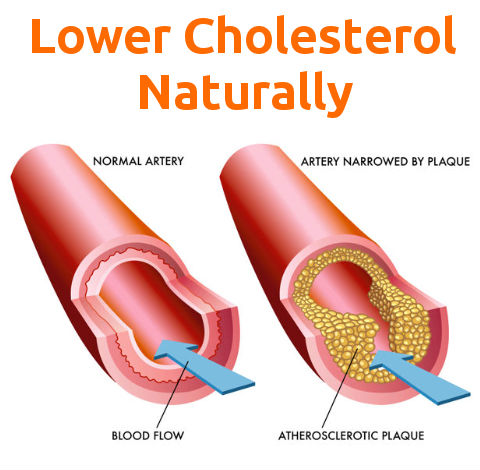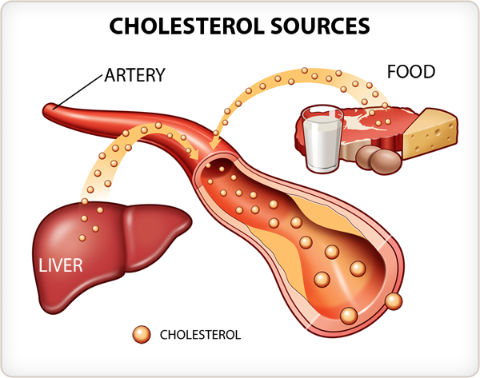Lower Cholesterol Naturally – Cholesterol Lowering Foods

What is Cholesterol? Bad vs. Good Cholesterol
Cholesterol – is a natural building material. No cell in our body can do without it, so the cholesterol entering our cells is not something harmful or dangerous. About 80% of cholesterol is produced by the body – namely in the liver, the other 20% comes from food.
The name “cholesterol” comes from the Greek word «chole» (bile) and «stereos» (solid), since it was first discovered in gallstones in solid form. Cholesterol circulates in the blood and is used as a structural component of all cells in the body (cholesterol is found in large amounts in the muscles, brain, and liver), and is involved in the development of many sex hormones.
In most cases, cholesterol is carried in the blood in the form of complex compounds, which are of two types: low-density lipoprotein (LDL) and high density lipoprotein (HDL). LDL (“bad cholesterol”) transports cholesterol from the liver to the arteries, where it is deposited on the walls as fatty substance in the form of plaques, while HDL cholesterol is called “good” lipoprotein because it removes LDL cholesterol from the walls of the arteries, reducing the risk of atherosclerosis.
Results of population studies have shown that the increased risk of cardiovascular diseases, and the likelihood of death from their complications (thrombosis, cardiac arrhythmias, heart attack and stroke) is connected both with the increase in total cholesterol and LDL cholesterol, and decrease in HDL cholesterol.
Every 1% reduction in LDL cholesterol reduces the risk of cardiovascular diseases by about 1%. The same increase in HDL by 1% reduces that risk by 2-4%. Regular monitoring of changes in cholesterol, triglycerides, LDL and HDL in blood will help to reveal any initial violations in time in order to begin treatment.

Lower cholesterol naturally and cholesterol lowering foods
-
- Weight loss
Excess weight is observed in most of the U.S. population. The famous Framingham Heart Study found a clear relationship between blood cholesterol and body weight. Every pound of fat contains 85 miles of capillaries through which the heart must pump blood, in addition. Therefore, losing even a few pounds results in the increase of HDL (good cholesterol) and reduces the risk of atherosclerosis.
-
- The Diet
Scientific studies have shown that cholesterol eaten had little effect on blood cholesterol levels. For most of us, it is more important how much saturated fats and trans fats are there in the daily ration. However, there is the daily rate of consumption of cholesterol with food: it is 300 mg for healthy people and 200 mg for people at risk. One large egg has about 186 mg of cholesterol. So, just giving up the products causing production of bad cholesterol is not enough. In order to maintain normal levels of “good” cholesterol and help remove the excess of the “bad” one, it is important to regularly eat foods that contain monounsaturated fats, omega polyunsaturated fatty acids, fiber and pectin.
-
- Omega-3 fatty acids
Omega-3 fatty acids are found mostly in fish oil. It is proved that the regular intake of them prevents blood clots and reduces the level of triglycerides. All that helps to reduce the risk of atherosclerosis. Omega-3 can be consumed as supplements or obtained from natural products: flaxseed, canola and primrose oil.
-
- Nuts
Nuts are extremely rich in natural monounsaturated fatty acids. It is recommended to eat at least 30 grams of nuts five times a week. Moreover it is possible to eat not only hazelnuts and walnuts, but also almonds, pine nuts, Brazil nuts, cashews and pistachios.
-
- Green tea contains compounds that prevent atherosclerosis.
- Legumes
In protein content, legumes are similar to meat. One study showed that men who had eaten one cup of cooked beans a day in just three weeks, had a decrease in cholesterol by 20%.
-
- Oats
An American study revealed that medical students who had eaten 2 oat bran rolls a day for 4 weeks, their total cholesterol decreased by 5.3%.
-
- Corn
Energy value of corn is only 97 calories/100g; in addition, corn oil helps reduce appetite and does not contain cholesterol. A study of American nutritionists showed that corn bran lowers cholesterol as effectively as oat bran and beans.
-
- Carrots
Regular consumption of only 2 raw carrots a day reduces cholesterol by 10-20%.
-
- Blue, purple and red fruits
After 1 month of daily drinking 150-170 ml of pure cranberry juice (usually it should be diluted with 3 parts of water), HDL increased by 10%. If you eat about 150 grams of berries, puree or nectar per day (blueberries, cranberries, black currants, strawberries, raspberries and black chokeberry), in 8 weeks your HDL cholesterol may increase by 5%. Polyphenols contained in blueberries, pomegranates, cranberries and red grapes, raise HDL.
Physical exercises
- In just 2 months after the start of aerobic exercises, most people had “good” cholesterol increase by 5%. It’s better to choose the exercises that boost heart rate: running, swimming and brisk walking.
Giving up smoking
- The risk of cardiovascular diseases for smokers is up to 300 times greater than for non-smokers. Complete cessation of smoking alone increases the concentration of “good” cholesterol by 10%, not to mention the lung cancer risk reduction.
Take a look at another article here to find out how understanding cholesterol can reduce your risk for heart disease.
RL Meena
May 1, 2014 @ 1:26 am
How can we forget the contribution of garlic in reducing bad cholesterol?